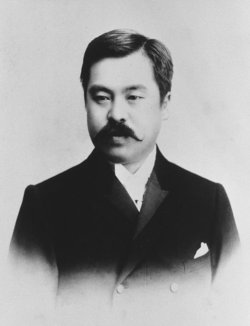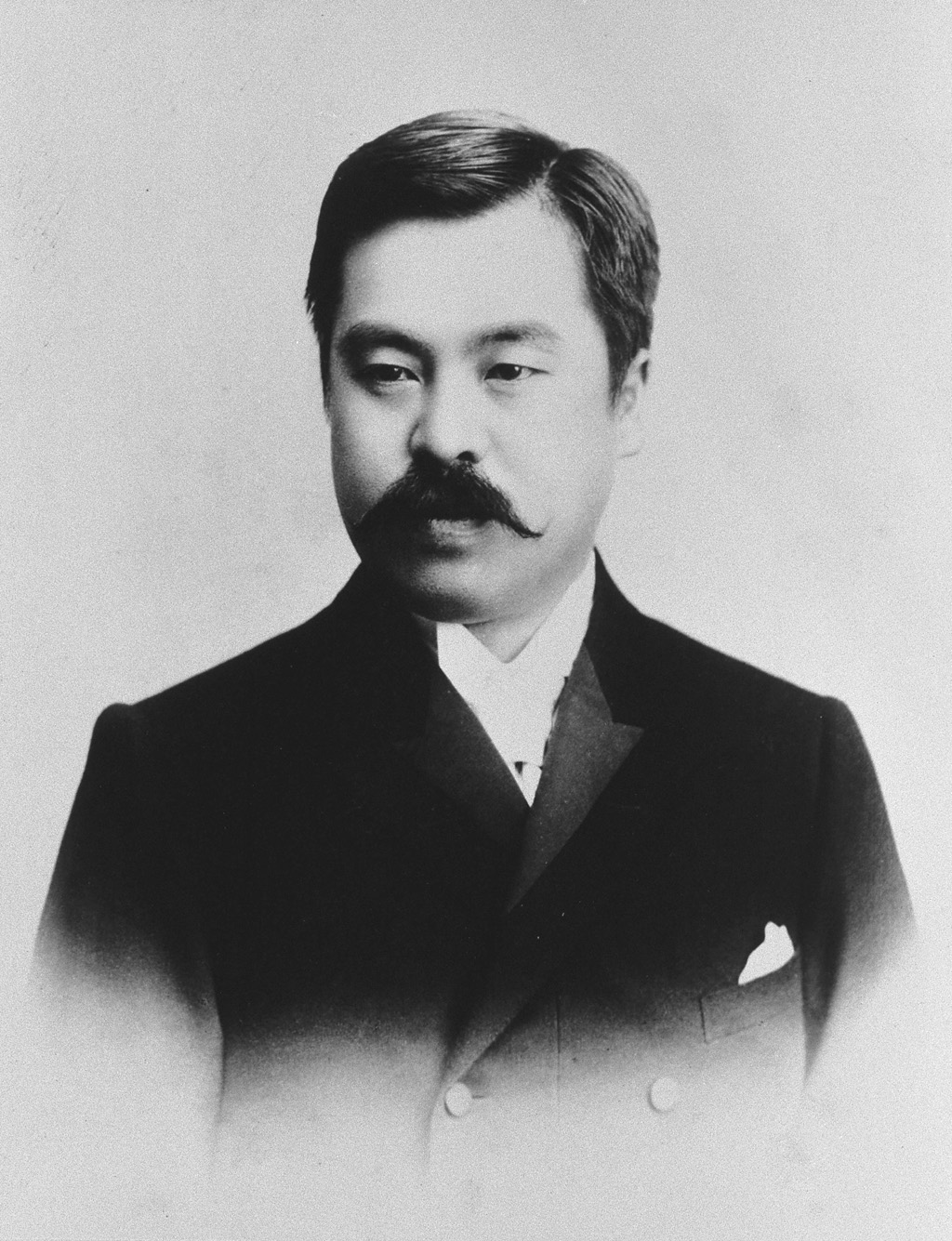Born in Kyoto, Atsumaro Konoe was the heir of the powerful Konoe family in Japan, one of the five regent houses of the Fujiwara clan. During his youth, his father Konoe Tadafusa (24 Sep 1838 – 16 Jul 1873) died, and he was raised by his grandfather Tadahiro Konoe. His mother was a daughter of Shimazu Nariakira. Frail, he had problems to study at university but learned English by himself.
After the Meiji Restoration of 1868, the Konoe family rank changed and he received the title of Prince (Koshaku) under the new kazoku system of peerage. From 1885 to 1890 Konoe visited Europe and studied at the University of Bonn and the University of Leipzig in Germany. When he returned to Japan, he became a member of the House of Lords and Chairman in 1895 of Gakushuin school for aristocrats.
Konoe later became the 3rd President of the House of Lords and chair of the 10th to the 18th Session from 3 October 1896 until 4 December 1903. From 1903, he was also member of the Privy Council during the same time.
Konoe is criticized for its policies based on clans, which continue to dominate the political scene in Japan. In foreign policy, Konoe is a central figure of the Pan Asian movement. He founded the pro-Asia political movement called the "common culture of society in East Asia" (東亜同文書院, Toa Dobun Shoin) which advocated mutual understanding and improving relations between Japan and China after the Sino-Japanese war (1894-1895). The company founded the "College of the common culture of East Asia" (東亜同文書院, Toa Dobun Shoin) in Nanjing in 1900 and moved to Shanghai a year later. The school taught Japanese students wishing to learn Mandarin and Chinese culture and financed a school in Tokyo for Chinese students wishing to make higher education in Japan. The company published an academic journal and a "Complete Book on economic conditions in China" which contained 11,000 pages. Graduates of both schools are highly sought after by the Japanese army, Japanese intelligence services and ultranationalist organizations for their ability in foreign languages and their significant knowledge of China. Many graduates work for the government of Manchukuo during the 1930s.
In August 1903, Konoe founded the "anti-Russian society" (対露同志会, Tairo Doshikai) Advocating an aggressive foreign policy in direction of the Russian empire because it perceived it as a threat to the independence of Korea, China and Japan. Konoe personally request that Japan declare war on Russia, but died before the outbreak of the Russo-Japanese war end in 1904.
His grave is in the cemetery of the Konoe family daitoku-ji in Kyoto, Japan.
Born in Kyoto, Atsumaro Konoe was the heir of the powerful Konoe family in Japan, one of the five regent houses of the Fujiwara clan. During his youth, his father Konoe Tadafusa (24 Sep 1838 – 16 Jul 1873) died, and he was raised by his grandfather Tadahiro Konoe. His mother was a daughter of Shimazu Nariakira. Frail, he had problems to study at university but learned English by himself.
After the Meiji Restoration of 1868, the Konoe family rank changed and he received the title of Prince (Koshaku) under the new kazoku system of peerage. From 1885 to 1890 Konoe visited Europe and studied at the University of Bonn and the University of Leipzig in Germany. When he returned to Japan, he became a member of the House of Lords and Chairman in 1895 of Gakushuin school for aristocrats.
Konoe later became the 3rd President of the House of Lords and chair of the 10th to the 18th Session from 3 October 1896 until 4 December 1903. From 1903, he was also member of the Privy Council during the same time.
Konoe is criticized for its policies based on clans, which continue to dominate the political scene in Japan. In foreign policy, Konoe is a central figure of the Pan Asian movement. He founded the pro-Asia political movement called the "common culture of society in East Asia" (東亜同文書院, Toa Dobun Shoin) which advocated mutual understanding and improving relations between Japan and China after the Sino-Japanese war (1894-1895). The company founded the "College of the common culture of East Asia" (東亜同文書院, Toa Dobun Shoin) in Nanjing in 1900 and moved to Shanghai a year later. The school taught Japanese students wishing to learn Mandarin and Chinese culture and financed a school in Tokyo for Chinese students wishing to make higher education in Japan. The company published an academic journal and a "Complete Book on economic conditions in China" which contained 11,000 pages. Graduates of both schools are highly sought after by the Japanese army, Japanese intelligence services and ultranationalist organizations for their ability in foreign languages and their significant knowledge of China. Many graduates work for the government of Manchukuo during the 1930s.
In August 1903, Konoe founded the "anti-Russian society" (対露同志会, Tairo Doshikai) Advocating an aggressive foreign policy in direction of the Russian empire because it perceived it as a threat to the independence of Korea, China and Japan. Konoe personally request that Japan declare war on Russia, but died before the outbreak of the Russo-Japanese war end in 1904.
His grave is in the cemetery of the Konoe family daitoku-ji in Kyoto, Japan.
Family Members
Sponsored by Ancestry
Advertisement
Advertisement




